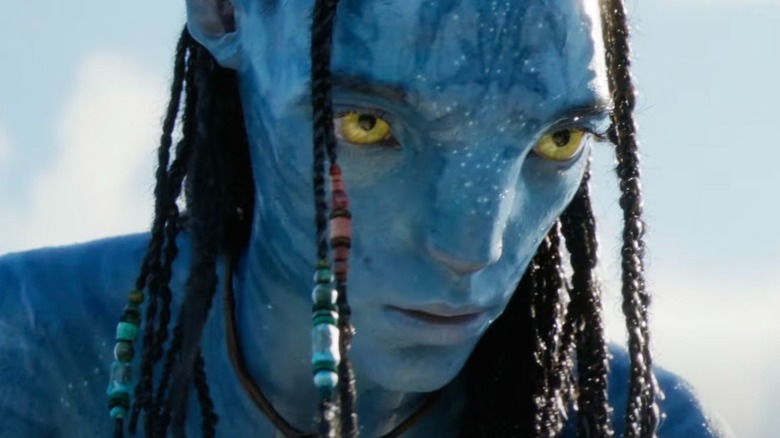An Avatar 2 Superfan Thinks They've Figured Out How Pandora Works
The beautifully strange world of Pandora is on full display in James Cameron's "Avatar: The Way of Water," and one superfan believes they've finally figured out how the alien moon's day-night cycle works, along with other things related to its extraordinary environment and specific place in the universe.
First introduced in 2009's "Avatar," the physics of Cameron's fictional oasis have never really been talked about on the big-screen by the characters at length, but there's been loads written about them. /Film recently reported on Pandora's astronomical bizarreness and all the ways it was able to experience an Earth-like day cycle. However, it's ultimately not clear what the actual length of a day might look like in the world of "Avatar."
As pointed out by /Film, Pandora orbits a fictional planet dubbed Polyphemus, which is actually a gas giant circling around a star known as Alpha Centauri A, aka Rigil Kentaurus. In both "Avatar" and "Avatar: The Way of Water," moviegoers are shown day-night cycles that are similar to Earth's — in the sense that they have daytime and nighttime — but in much different lengths. Per /Film, nights on Pandora typically last no more than 100 Earth minutes. So how long does a day last? And what's up with those eclipses?
Pandora's day-night cycle is estimated to be around 30-35 hours long, says Avatar superfan
According to Redditor and self-described "space nerd" u/songsofadistantsun, it's estimated that Pandora's day-night cycle is likely around 30 to 35 hours long — with it being not much different than a Terran day. The major difference is that instead of the moon experiencing daytime and nighttime because of Polyphemus' orbital period, it's being affected by how close it is to the massive gas giant and the eclipses that occur as a result.
"For a long time I thought the first movie was unrealistic, because it showed Pandora having a seemingly Earth-like day-night cycle," u/songsofadistantsun explained in a December 17 post. "This despite being that, like any other moon, it would be tidally locked to its (rather massive) parent, and thus have a 'day' in sync with its orbital period. But then I learned that Mimas — the Death Star-looking tenth moon of Saturn — has a 'day' only 23 hours long. Thus I learned that massive planets can make their inner moons orbit fast compared to ours ... and so theorized that Pandora is probably a lot closer to Polyphemus than I originally thought. The background visuals in the first movie are still inconsistent, but the day-night cycle actually makes sense now."
Now, u/songsofadistantsun could have easily just stopped right there and "Avatar" fans would have been more than happy with the analysis. But the Redditor chose to dive even deeper into Pandora's inner workings — including one other astronomical plot hole — and divulge their findings to fans.
The theory also explains Pandora's floating mountains
According to resident "space nerd" u/songsofadistantsun, the main reason for Pandora's floating mountains has to do with how close it is to Polyphemus and two of its other moons, which are briefly shown in the first "Avatar."
"We glimpsed two inner moons in the first movie, each almost certainly smaller than Luna," said u/songsofadistantsun. "Given how massive Pandora is in comparison, they'd all be locked in a strict orbital resonance with each other, similar to the 2:1 resonance of Io and Europa. Also like Io and Europa, the gravitational tugging between the moons and the gas giant is what's driving Pandora's geologic activity, such as the inner heat producing the strong magnetic fields that make the mountains float."
According to /Film, "Avatar" fan sites have listed Pandora's high axial tilt as being 29°, which has ultimately led to the occurrence of seasonal eclipses around the time of the equinoxes. Echoing this notion, Redditor u/songsofadistantsun said, "Therefore, we can assume that ['The World of Water'] happens during either Pandoran 'spring' or 'autumn,' while the absence of eclipses in the first movie sets it in 'summer' or 'winter.'" And if there's a summer and a winter, that means there could also very well be drastic weather changes, concludes u/songsofadistantsun.
"The high level of CO2 seems to be making the whole moon pretty tropical already, so I'm guessing there's a dry and rainy season?" they hypothesized.


